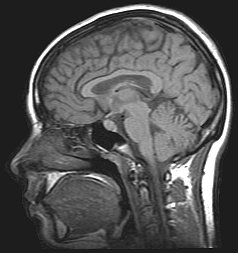Alcohol-related brain damage
Brain damage caused by alcohol consumption
Alcoholics can typically be divided into two categories, uncomplicated and complicated.]]
Alcohol-related brain damage (ARBD) refers to a range of conditions and symptoms that result from the chronic consumption of alcohol, leading to damage in the brain. This damage can manifest in various forms, including cognitive impairments, memory problems, and changes in behavior and personality.
Pathophysiology[edit | edit source]
Chronic alcohol consumption can lead to neurotoxicity, which affects the brain's structure and function. Alcohol is a central nervous system depressant that can cause neuronal death and disrupt the balance of neurotransmitters. Over time, excessive alcohol intake can lead to thiamine deficiency, which is a critical factor in the development of certain types of ARBD, such as Wernicke's encephalopathy and Korsakoff's syndrome.
Types of Alcohol-Related Brain Damage[edit | edit source]
Wernicke's Encephalopathy[edit | edit source]
Wernicke's encephalopathy is an acute neurological condition characterized by confusion, ataxia, and ophthalmoplegia. It results from a deficiency in thiamine (vitamin B1), which is often seen in individuals with chronic alcoholism due to poor nutritional intake and absorption.
Korsakoff's Syndrome[edit | edit source]
Korsakoff's syndrome is a chronic neurocognitive disorder that often follows Wernicke's encephalopathy. It is marked by severe memory impairment, confabulation, and difficulty in acquiring new information. This syndrome is also linked to thiamine deficiency and is considered a form of alcohol-related dementia.
Alcoholic Dementia[edit | edit source]
Alcoholic dementia is a broad term that encompasses various cognitive impairments resulting from long-term alcohol abuse. It includes deficits in memory, executive function, and visuospatial abilities. Unlike Korsakoff's syndrome, alcoholic dementia is not solely attributed to thiamine deficiency but also to the direct neurotoxic effects of alcohol.
Symptoms[edit | edit source]
The symptoms of ARBD can vary depending on the specific condition and the extent of brain damage. Common symptoms include:
- Memory loss
- Confusion
- Difficulty with coordination and balance
- Changes in personality and behavior
- Impaired judgment and decision-making
- Difficulty with learning new information
Diagnosis[edit | edit source]
Diagnosing ARBD involves a combination of clinical assessment, patient history, and neuroimaging techniques. Magnetic resonance imaging (MRI) and computed tomography (CT) scans can reveal structural changes in the brain associated with chronic alcohol use. Neuropsychological testing is also used to assess cognitive function and identify specific deficits.
Treatment[edit | edit source]
Treatment for ARBD focuses on abstinence from alcohol, nutritional support, and rehabilitation. Thiamine supplementation is crucial, especially in cases of Wernicke's encephalopathy and Korsakoff's syndrome. Cognitive rehabilitation and therapy can help improve cognitive function and quality of life.
Prognosis[edit | edit source]
The prognosis for individuals with ARBD varies. Early intervention and sustained abstinence from alcohol can lead to significant improvements in cognitive function and overall health. However, in cases where brain damage is extensive, some cognitive deficits may persist.
Prevention[edit | edit source]
Preventing ARBD involves reducing alcohol consumption and ensuring adequate nutritional intake, particularly of thiamine. Public health initiatives aimed at reducing alcohol abuse and promoting healthy lifestyles can also help prevent the development of ARBD.
Related pages[edit | edit source]
Search WikiMD
Ad.Tired of being Overweight? Try W8MD's physician weight loss program.
Semaglutide (Ozempic / Wegovy and Tirzepatide (Mounjaro / Zepbound) available.
Advertise on WikiMD
|
WikiMD's Wellness Encyclopedia |
| Let Food Be Thy Medicine Medicine Thy Food - Hippocrates |
Translate this page: - East Asian
中文,
日本,
한국어,
South Asian
हिन्दी,
தமிழ்,
తెలుగు,
Urdu,
ಕನ್ನಡ,
Southeast Asian
Indonesian,
Vietnamese,
Thai,
မြန်မာဘာသာ,
বাংলা
European
español,
Deutsch,
français,
Greek,
português do Brasil,
polski,
română,
русский,
Nederlands,
norsk,
svenska,
suomi,
Italian
Middle Eastern & African
عربى,
Turkish,
Persian,
Hebrew,
Afrikaans,
isiZulu,
Kiswahili,
Other
Bulgarian,
Hungarian,
Czech,
Swedish,
മലയാളം,
मराठी,
ਪੰਜਾਬੀ,
ગુજરાતી,
Portuguese,
Ukrainian
Medical Disclaimer: WikiMD is not a substitute for professional medical advice. The information on WikiMD is provided as an information resource only, may be incorrect, outdated or misleading, and is not to be used or relied on for any diagnostic or treatment purposes. Please consult your health care provider before making any healthcare decisions or for guidance about a specific medical condition. WikiMD expressly disclaims responsibility, and shall have no liability, for any damages, loss, injury, or liability whatsoever suffered as a result of your reliance on the information contained in this site. By visiting this site you agree to the foregoing terms and conditions, which may from time to time be changed or supplemented by WikiMD. If you do not agree to the foregoing terms and conditions, you should not enter or use this site. See full disclaimer.
Credits:Most images are courtesy of Wikimedia commons, and templates, categories Wikipedia, licensed under CC BY SA or similar.
Contributors: Prab R. Tumpati, MD




